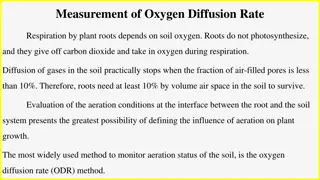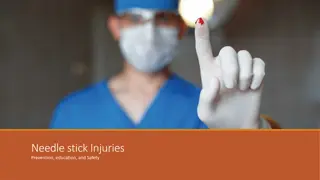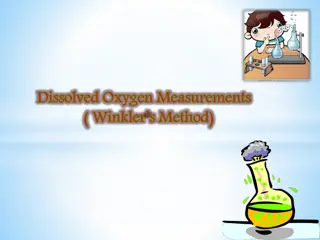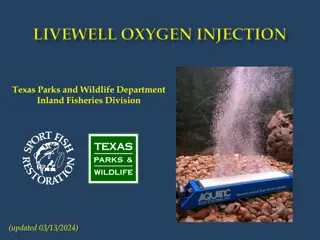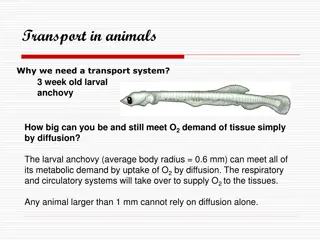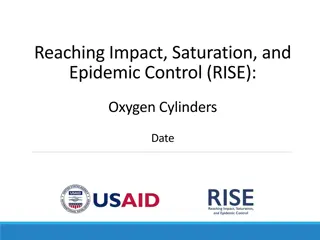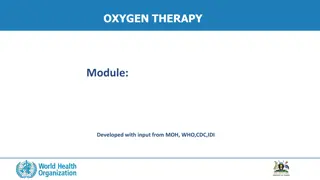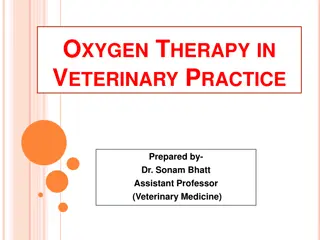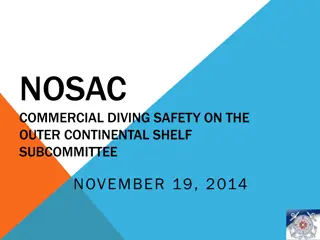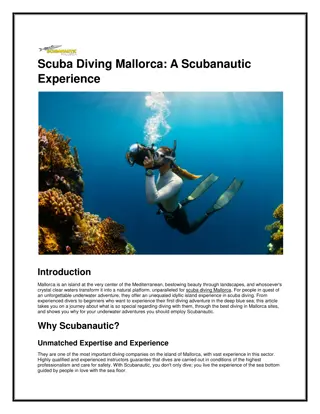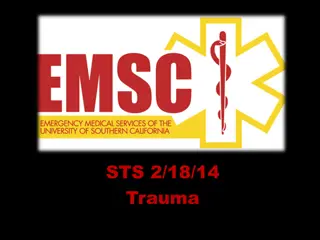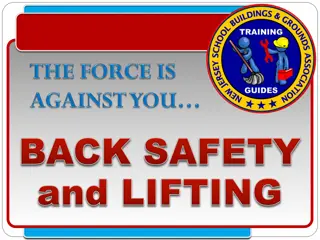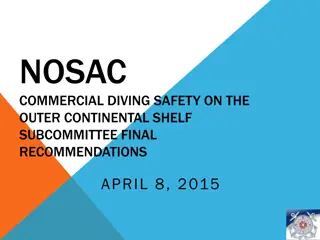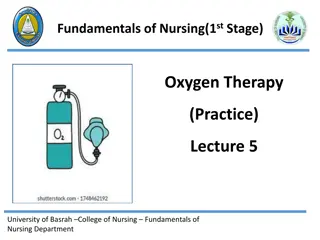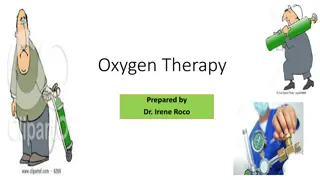Emergency Oxygen for Scuba Diving Injuries
This content provides an overview of emergency oxygen for scuba diving injuries, including atmospheric gases, oxygen delivery systems, handling safety, and more. It also includes quiz questions related to oxygen and its importance in the body.
Download Presentation

Please find below an Image/Link to download the presentation.
The content on the website is provided AS IS for your information and personal use only. It may not be sold, licensed, or shared on other websites without obtaining consent from the author.If you encounter any issues during the download, it is possible that the publisher has removed the file from their server.
You are allowed to download the files provided on this website for personal or commercial use, subject to the condition that they are used lawfully. All files are the property of their respective owners.
The content on the website is provided AS IS for your information and personal use only. It may not be sold, licensed, or shared on other websites without obtaining consent from the author.
E N D
Presentation Transcript
Emergency Oxygen Emergency Oxygen for Scuba Diving Injuries
Getting Starting Introductions Emergency Oxygen Instructor & Staff Emergency Oxygen Provider Candidates BLS: CPR & First Aid Provider Registration Form Statement of Understanding DAN Membership Form Other Administrative Procedures Course Logistics
Course Overview Emergency Emergency for Scuba Diving Injuries
Course Overview Atmospheric Gases Respiration and Circulation Decompression Illness Oxygen and Dive Injuries Handling Oxygen Safely Oxygen Delivery Systems and Components Skill Development Final Assessment and Review
Chapter 2 Review Quiz Questions
Question 1 Oxygen is a clear, odourless gas essential to life a. True b. False Answer: a. True
Question 2 The atmospheric air we inhale contains % oxygen a. 12 b. 16 c. 21 d. 27 Answer: c. 21
Question 3 The air we exhale contains % oxygen a. 12 b. 16 c. 21 d. 27 Answer: b. 16
Question 4 Oxygen is carried throughout the body by a. white blood cells b. red blood cells c. bone marrow d. blood plasma Answer: b. red blood cells
Question 5 Carbon dioxide is a. a waste product of metabolism b. a toxic gas c. essential for life d. an inert gas Answer: b. red blood cells
Question 6 Nitrogen comprises % atmospheric air a. 21 b. 27 c. 67 d. 78 Answer: d. 78
Question 7 Carbon monoxide is a. a waste product of metabolism b. a toxic gas c. essential for life d. an inert Answer: d. 78
Chapter 3 Review Quiz Questions
Question 1 Providing a high concentration of oxygen to an injured diver may provide these benefits a. acceleration of inert-gas elimination b. reduce bubble size c. enhance oxygen delivery to tissues d. reduce swelling e. all of the above Answer: e. all of the above
Question 2 The primary goal of providing the highest concentration of oxygen possible to an injured diver is to facilitate inert-gas washout and improve oxygen delivery to compromised tissues a. True b. False Answer: a. True
Question 3 Percentage of oxygen delivered when using a demand valve is influenced by a. flow rate b. mask fit c. mask seal d. Both b and c Answer: d. mask fit and mask seal
Question 4 The initial flow rate for constant-flow oxygen delivery is a. 2-4 lpm b. 10-15 lpm c. 20-25 lpm d. the rate the injured diver will tolerate Answer: b. 10-15 lpm
Question 5 In remote areas, the priority in oxygen delivery is a. to conserve oxygen supplies b. to maximise highest inspired fraction of oxygen c. limit the flow of oxygen Answer: b. to maximise highest inspired fraction of oxygen
Question 6 Oxygen toxicity, whether CNS or pulmonary, is not a concern when providing oxygen first aid to an injured diver a. True b. False Answer: a. True
Question 7 Which of the following is not a symptom of non-fatal drowning a. difficulty breathing b. rapid pulse c. cyanosis (bluish coloured lips) d. abdominal distention e. chest pain Answer: b. rapid pulse
Question 8 As a first responder to a non-fatal drowning, your primary role is to a. monitor vital signs b. provide supplemental oxygen c. transport victim to the nearest medical facility d. all of the above Answer: d. all of the above
Chapter 4 Review Quiz Questions
Question 1 Oxygen is one element of the fire triangle a. True b. False Answer: a. True
Question 2 The risks of handling oxygen can be reduced by a. keeping the oxygen units free of hydrocarbons found in oils and lubricants often kept on dive boats b. slowly opening the oxygen cylinder c. keeping the unit away from the heat of the sun d. all of the above Answer: c. keeping the unit away from the heat of the sun
Question 3 Contact with grease and exposure to high temperatures are of no concern with oxygen equipment a. True b. False Answer: b. False
Question 4 With what grade of oxygen should an oxygen cylinder for diving first aid be filled? a. aviator or industrial grade b. medical grade only c. medical or industrial grade d. aviator or medical grade Answer: bd. aviator or medical grade
Question 5 Methods for obtaining oxygen fills may include a. prescription b. documentation of training in oxygen c. delivery d. prospective prescription e. all of the above Answer: d. prospective prescription
Question 6 When should an oxygen unit s components and cylinder pressure be checked? a. every two years b. before every outing c. every week d. Annually Answer: b. before every outing
Question 7 An oxygen unit should be stored a. with the valve closed b. in its protective case c. assembled d. all of the above Answer: d. all of the above
Question 8 It is not necessary to clean oxygen parts and masks a. True b. False Answer: b. False
Chapter 5 Review Quiz Questions
Question 1 Which of the following is not part of an oxygen delivery systems a. oxygen cylinder b. pressure-reducing regulator c. lubricants to facilitate assembly d. oxygen hose e. face mask Answer: c. lubricants to facilitate assembly
Question 2 What is the primary consideration when choosing an oxygen cylinder? a. capacity b. distance to medical aid c. cylinder markings Answer: a. capacity
Question 3 A multifunction regulator is preferred in emergency oxygen for scuba diving injuries because it can provide emergency oxygen to two injured divers at once a. True b. False Answer: a. True
Question 4 An oxygen cylinder should be switched during care when the pressure drops below 200 psi if another cylinder is available or, if another cylinder is not available, use the cylinder until it is empty a. True b. False Answer: a. True
Question 5 Oxygen cylinders are subject to periodic visual and hydrostatic testing a. True b. False Answer: a. True
Question 6 Oxygen cylinder marking colours are standardised throughout the world to avoid confusion a. True b. False Answer: b. False
Question 7 Oxygen regulators are fitted with a pin indexing system to prevent use on other cylinder valves that may not contain oxygen a. True b. False Answer: a. True
Question 8 A demand valve flows only when the injured diver inhales, allowing the oxygen to last longer a. True b. False Answer: a. True
Question 9 A bag valve mask a. is a self-inflating bag with a mask that aids in rescue breathing b. has a manual trigger that initiates oxygen flow c. is best used by two rescuers working together d. a and c Answer: a. True
Question 10 Manually triggered ventilators a. allow rescuers to deliver high concentrations of oxygen to non-breathing or inadequately breathing divers b. can also function as a demand valve c. is best used by two rescuers d. all of the above Answer: d. all of the above
Question 11 A constant flow mask that is recommended when a breathing injured diver cannot activate the demand inhalator valve or when there is more than one injured diver is a a. non-rebreather mask b. oronasal resuscitation mask c. bag valve mask Answer: a. non-rebreather mask
Oxygen Provider Skills Practical Skills Session
Oxygen Provider Skills Oxygen Equipment Assembly and Disassembly Demand Inhalator Valve Non-Rebreather Mask Resuscitation with a Bag Valve Mask Using an MTV Providing Oxygen to Two Injured Divers (optional skill)
Questions Emergency Oxygen for Scuba Diving Injuries



